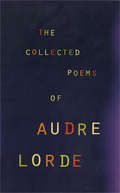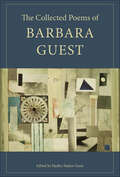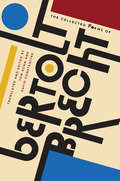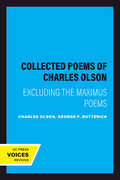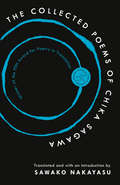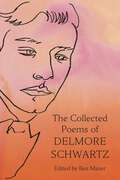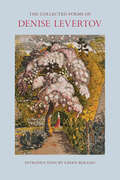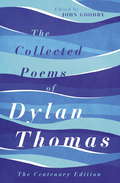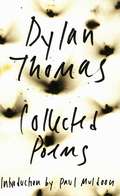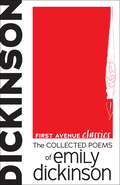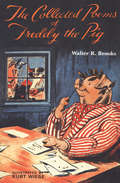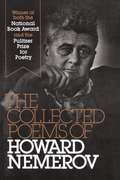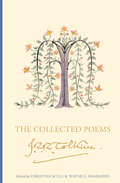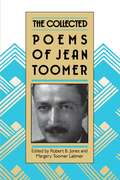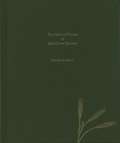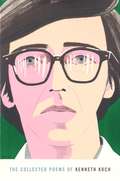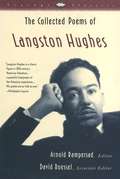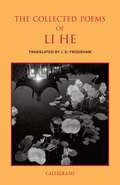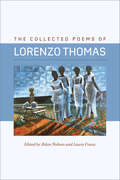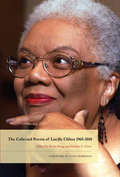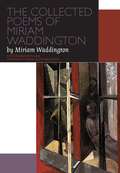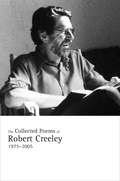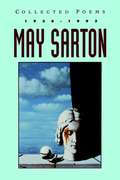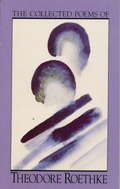- Table View
- List View
The Collected Poems of Audre Lorde
by Audre Lorde<P>A complete collection--over 300 poems--from one of this country's most influential poets. <P>"These are poems which blaze and pulse on the page."--Adrienne Rich <P>"The first declaration of a black, lesbian feminist identity took place in these poems, and set the terms--beautifully, forcefully--for contemporary multicultural and pluralist debate."--Publishers Weekly <P>"This is an amazing collection of poetry by . . . one of our best contemporary poets. . . . Her poems are powerful, often political, always lyrical and profoundly moving."--Chuckanut Reader Magazine <P>"What a deep pleasure to encounter Audre Lorde's most potent genius . . . you will welcome the sheer accessibility and the force and beauty of this volume."--Out Magazine
The Collected Poems of Barbara Guest (Wesleyan Poetry Series)
by Barbara GuestWinner of the SFSU Poetry Center Book Award (2010)One of the most notable members of the New York School—and its best-known woman—Barbara Guest began writing poetry in the 1950s in company that included John Ashbery, Kenneth Koch, Frank O'Hara, and James Schuyler. And from the beginning, her practice placed her at the vanguard of American writing. Guest's poetry, saturated in the visual arts, extended the formal experiments of modernism, and played the abstract qualities of language against its sensuousness and materiality. Now, for the first time, all of her published poems have been brought together in one volume, offering readers and scholars unprecedented access to Guest's remarkable visionary work. This Collected Poems moves from her early New York School years through her more abstract later work, including some final poems never before published. Switching effortlessly from the real to the dreamlike, the observed to the imagined, this is poetry both gentle and piercing—seemingly simple, but truly and beautifully dislocating.
The Collected Poems of Bertolt Brecht
by David Constantine Tom KuhnWidely celebrated as the greatest German playwright of the twentieth century, Bertolt Brecht was also, as George Steiner observed, “that very rare phenomenon, a great poet, for whom poetry is an almost everyday visitation and drawing of breath.” Hugely prolific, Brecht also wrote more than two thousand poems―though fewer than half were published in his lifetime, and early translations were heavily censored. Now, award-winning translators David Constantine and Tom Kuhn have heroically translated more than 1,200 poems in the most comprehensive English collection of Brecht’s poetry to date. Written between 1913 and 1956, these poems celebrate Brecht’s unquenchable “love of life, the desire for better and more of it,” and reflect the technical virtuosity of an artist driven by bitter and violent politics, as well as by the untrammeled forces of love and erotic desire. A monumental achievement and a reclamation, The Collected Poems of Bertolt Brecht is a must-have for any lover of twentieth-century poetry.
The Collected Poems of Charles Olson: Excluding the Maximus Poems
by Charles OlsonA seminal figure in post-World War II literature, Charles Olson (1910-1970) has helped define the postmodern sensibility. His poetry is marked by an almost limitless range of interest and extraordinary depth of feeling. Olson's themes are among the largest conceivable: empowering love, political responsibility, historical discovery and cultural reckoning, the wisdom of dreams and the transformation of consciousness—all carried in a voice both intimate and grand, American and timeless, impassioned and coolly demanding. Until recently, Olson's reputation as a major figure in American literature has rested primarily on his theoretical writings and his epic work, the Maximus Poems. With The Collected Poems an even more impressive Olson emerges. This volume brings together all of Olson's work and extends the poetic accomplishment that influenced a generation. Charles Olson was praised by his contemporaries and emulated by his successors. He was declared by William Carlos Williams to be "a major poet with a sweep of understanding of the world, a feeling for other men that staggers me." His indispensable essays, "Projective Verse" and "Human Universe," and his study of Melville, Call Me Ishmael, remain as fresh today as when they were written.
The Collected Poems of Chika Sagawa (Modern Library Torchbearers)
by Chika SagawaWinner of the PEN Award for Poetry in Translation • The electrifying collected works of &“one of the most innovative and prominent avant-garde poets in early twentieth-century Japan&” (The New Yorker). Translated by and with an introduction by Sawako NakayasuAn important and daringly experimental voice in Tokyo&’s avant-garde poetry scene, Chika Sagawa broke with the gender-bound traditions of Japanese poetry. Growing up in isolated rural Japan, Sagawa moved to Tokyo at seventeen, and begin publishing her work at eighteen.She was immediately recognized as a leading light of the male-dominated Japanese literary scene; her work combines striking, unique imagery with Western influences. The results are short, sharp, surreal poems about human fragility and the beauty of nature from Japan&’s first female Modernist poet. The Modern Library Torchbearers series features women who wrote on their own terms, with boldness, creativity, and a spirit of resistance. AMERICAN INDIAN STORIES • THE AWAKENING • THE CUSTOM OF THE COUNTRY • THE HEADS OF CERBERUS • LADY AUDLEY&’S SECRET • LOVE, ANGER, MADNESS • PASSING • THE RETURN OF THE SOLDIER • THERE IS CONFUSION • THE TRANSFORMATION OF PHILIP JETTAN • VILLETTE
The Collected Poems of Delmore Schwartz
by Delmore SchwartzThe first complete collection of the poetry of Delmore Schwartz, “the most underrated poet of the twentieth century" (John Berryman).When Delmore Schwartz published his first short story, “In Dreams Begin Responsibilities,” in Partisan Review in 1937, he became an instant literary celebrity. After the appearance of his first book (by the same name), he was inundated with praise. The famed poet Allen Tate wrote to him, “Your poetic style is beyond any doubt the first real innovation that we’ve had since Eliot and Pound,” and T. S. Eliot himself wrote Schwartz a letter asking him to compose more poetry. The brilliant start of his career is matched perhaps only by its tragic end, a lonely death after an extended period of alcoholism, depression, and derangement. Today, more than fifty years after his death in 1966, Schwartz is often remembered for the tragedy of his life rather than for the innovation and sad brilliance of his greatest work.This book brings together all of Schwartz’s poetry for the very first time, from his groundbreaking debut collection to his unpublished late work, which he kept writing until his death. Accompanied by Ben Mazer’s illustrative notes and introduction, The Collected Poems of Delmore Schwartz offers readers the long-awaited opportunity to rediscover one of the most influential and original poets of the twentieth century. As Mazer writes in his introduction, “It is the poems that count now. And it is the glory of the poems that survives here, awaiting new life.”
The Collected Poems of Denise Levertov
by Denise LevertovThe landmark collected work of one of the greatest poets of the 20th century, now in paperback. How splendid and impressive to have a complete, clear, and unobstructed view of Denise Levertov. Covering more than six decades and including, chronologically, every poem she ever published, Levertov’s Collected Poems presents her marvelous, groundbreaking work in full. Born in England, Denise Levertov emigrated in 1948 to the United States, where she was acclaimed by Kenneth Rexroth in The New York Times as “the most subtly skillful poet of her generation, the most profound, the most modest, the most moving.” A staunch anti-war activist and environmentalist, and the winner of the Robert Frost Medal, the Shelley Memorial Award, and the Lannan Prize, Denise Levertov inspired generations of writers. New Directions is proud to publish this landmark collected poems of one of the twentieth century’s greatest poets.
The Collected Poems of Dylan Thomas: The Centenary Edition
by Dylan ThomasLike Shakespeare and Joyce before him, Dylan Thomas expanded our sense of what the English language can do. Rhythmically forceful yet subtly musical and full of memorable lines, his poems are anthology favourites; his 'play for voices' Under Milk Wood a modern classic. Much loved by The Beatles and Bob Dylan, he is a cultural icon and continues to inspire artists today.This new edition, released to commemorate the centenary of Thomas's birth, collects more of his poems together in a single volume than ever before. With recently discovered material and accessible critique from Dylan Thomas expert John Goodby, it looks at Thomas's body of work in a fresh light, taking us to the beating heart of his poetry.
The Collected Poems of Dylan Thomas: The Original Edition
by Dylan Thomas Paul MuldoonThe original and classic The Collected Poems of Dylan Thomas is available once again, now with a brilliant new preface by Paul Muldoon. The Collected Poems of Dylan Thomas contains poems that Thomas personally decided best represented his work. A year before its publication Thomas died from swelling of the brain triggered by excessive drinking. (A piece of New Directions history: it was our founder James Laughlin who identified Thomas' body at the morgue of St. Vincent's Hospital.) Since its initial publication in 1953, this book has become the definitive edition of the poet's work. Thomas wrote "Prologue" addressed to "my readers, the strangers" -- an introduction in verse that was the last poem he would ever write. Also included are classics such as "And Death Shall Have No Dominion," "Do Not Go Gentle into that Good Night," and "Fern Hill" that have influenced generations of artists from Bob Dylan (who changed his last name from Zimmerman in honor of the poet), to John Lennon (The Beatles included Thomas' portrait on the cover of Sgt. Pepper's Lonely Hearts Club Band); this collection even appears in the film adaptation of Cormac McCarthy's The Road when it is retrieved from the rubble of a bookshelf. And death shall have no dominion. Dead men naked they shall be one With the man in the wind and the west moon; When their bones are picked clean and their clean bones gone, They shall have stars at elbow and foot; Though they go mad they shall be sane, Though they sink through the sea they shall rise again, Though lovers be lost love shall not: And death shall have no dominion. (From "And Death Shall Have No Dominion")
The Collected Poems of Emily Dickinson (First Avenue Classics ™)
by Emily DickinsonThis collection of Emily Dickinson's work contains 444 of the nearly 1,800 poems that the prolific yet reclusive American poet privately penned during her lifetime. Although her bold and non-traditional writing style met with mixed reviews when first published, Dickinson is now considered one of America's greatest poets. Included here are such famous poems as "Because I could not stop for Death", "I'm nobody! Who are you?", and "Hope is the thing with feathers". Themes of love, loss, death, and immortality imbue Dickinson's work with a timeless quality; her unconventional poetry continues to provide insight into the human condition. This is an unabridged compilation of three series of Dickinson's poetry edited and published by her friends after her death—the first series in 1890, the second in 1891, and the third in 1896.
The Collected Poems of Freddy the Pig (Freddy the Pig #21)
by Walter R. BrooksThe weather, all animals (with special emphasis on the peculiar attributes of pigs), joy and sorrow, the utility of facial features, and a world of other subjects are poetically worked over by the world&’s most distinguished pig-of-letters, Freddy—the Bard of Bean Farm. Whether he&’s happy or sad Freddy is ever the poet, and his verse—both heavy and light—has created an international fuss among the less gifted pigs and poets. And if Freddy&’s poetry seems a bit hammy in spots, well . . .
The Collected Poems of Howard Nemerov
by Howard NemerovThe former Poet Laureate of the United States, Nemerov gives us a lucid and precise twist on the commonplaces of everyday life.The Collected Poems of Howard Nemerov won both the National Book Award and the Pulitzer Prize in 1978. "Howard Nemerov is a witty, urbane, thoughtful poet, grounded in the classics, a master of the craft. It is refreshing to read his work. . . . "—Minneapolis Tribune "The world causes in Nemerov a mingled revulsion and love, and a hopeless hope is the most attractive quality in his poems, which slowly turn obverse to reverse, seeing the permanence of change, the vices of virtue, the evanescence of solidities and the errors of truth."—Helen Vendler, New York Times Book Review
The Collected Poems of J.R.R. Tolkien Box Set: Three-Volume Box Set
by J. R. TolkienThe first-ever publication of the collected poems of J.R.R. Tolkien, spanning almost seven decades of the author’s life and presented in an elegant three-volume hardcover boxed set.J.R.R. Tolkien aspired to be a poet in the first instance, and poetry was part of his creative life no less than his prose, his languages, and his art. Although Tolkien’s readers are aware that he wrote poetry, if only from verses in The Hobbit and The Lord of the Rings, its extent is not well known, and its qualities are underappreciated. Within his larger works of fiction, poems help to establish character and place as well as further the story; as individual works, they delight with words and rhyme. They express his love of nature and the seasons, of landscape and music, and of words. They convey his humor and his sense of wonder.The earliest work in this collection, written for his beloved, is dated to 1910, when Tolkien was eighteen. More poems would follow during his years at Oxford, some of them very elaborate and eccentric. Those he composed during the First World War, in which he served in France, tend to be concerned not with trenches and battle, but with life, loss, faith, and friendship, his longing for England and the wife he left behind. Beginning in 1914, elements of his legendarium, “The Silmarillion,” began to appear, and the “Matter of Middle-earth” would inspire much of Tolkien’s verse for the rest of his life.The Collected Poems of J.R.R. Tolkien presents almost 200 works across three volumes, including more than 60 that have never before been seen. The poems are deftly woven together with commentary and notes by world-renowned Tolkien scholars Christina Scull & Wayne G. Hammond, placing them in the context of Tolkien’s life and literary accomplishments and creating a poetical biography that is a unique and revealing celebration of J.R.R. Tolkien.
The Collected Poems of Jean Toomer
by Margot Toomer Latimer Robert B. JonesThis volume is the only collected edition of poems by Jean Toomer, the enigmatic American writer, Gurdjieffian guru, and Quaker convert who is perhaps best known for his 1923 lyrical narrative Cane. The fifty-five poems here -- most of them previously unpublished -- chart a fascinating evolution of artistic consciousness.The book is divided into sections reflecting four distinct periods of creativity in Toomer's career. The Aesthetic period includes Imagist, Symbolist, and other experimental pieces, such as "Five Vignettes," while "Georgia Dusk" and the newly discovered poem "Tell Me" come from Toomer' s Ancestral Consciousness period in the early 1920s. "The Blue Meridian" and other Objective Consciousness poems reveal the influence of idealist philosopher Georges Gurdjieff. Among the works of this period the editor presents a group of local color poems picturing the landscape of the American Southwest, including "Imprint for Rio Grande." "It Is Everywhere," another newly discovered poem, celebrates America and democratic idealism. The Quaker religious philosophy of Toomer's final years is demonstrated in such Christian Existential works as "They Are Not Missed" and "To Gurdjieff Dying."Robert Jones's clear and comprehensive introduction examines the major poems in this volume and serves as a guide through the stages of Toomer's evolution as an artist and thinker. The Collected Poems of Jean Toomer will prove essential to Toomer's admirers as well as to scholars and students of modern poetry, Afro-American literature, and American studies.
The Collected Poems of John Crowe Ransom (First Edition)
by John Crowe Ransom Ben MazerA complete edition of the poems of John Crowe Ransom, edited by Ben Mazer.
The Collected Poems of Kenneth Koch
by Kenneth KochKenneth Koch has been called "one of our greatest poets" by John Ashbery, and "a national treasure" in the 2000 National Book Award Finalist Citation. Now, for the first time, all of the poems in his ten collections-from Sun Out, poems of the 1950s, to Thank You, published in 1962, to A Possible World, published in 2002, the year of the poet's death-are gathered in one volume.Celebrating the pleasures of friendship, art, and love, the poetry of Kenneth Koch has been dazzling readers for fifty years. Charter member-along with Frank O'Hara, John Ashbery, and James Schuyler-of the New York School of poets, avant-garde playwright and fiction writer, pioneer teacher of writing to children, Koch gave us some of the most exciting and aesthetically daring poems of his generation.These poems take sensuous delight in the life of the mind and the heart, often at the same time: "O what a physical effect it has on me / To dive forever into the light blue sea / Of your acquaintance!" ("In Love with You").Here is Koch's early work: love poems like "The Circus" and "To Marina" and such well-remembered comic masterpieces as "Fresh Air," "Some General Instructions," and "The Boiling Water" ("A serious moment for the water is when it boils"). And here are the brilliant later poems-"One Train May Hide Another," the deliciously autobiographical address in New Addresses, and the stately elegy "Bel Canto"-poems that, beneath a surface of lightness and wit, speak with passion, depth, and seriousness to all the most important moments in one's existence.Charles Simic wrote in The New York Review of Books that, for Koch, poetry "has to be constantly saved from itself. The idea is to do something with language that has never been done before." In the ten exuberant, hilarious, and heartbreaking books of poems collected here, Kenneth Koch does exactly that.From the Hardcover edition.
The Collected Poems of Langston Hughes
by Langston Hughes Arnold RampersadSpanning five decades and comprising 868 poems (nearly 300 of which have never before appeared in book form), this magnificent volume is the definitive sampling of a writer who has been called the poet laureate of African America--and perhaps our greatest popular poet since Walt Whitman. Here, for the first time, are all the poems that Langston Hughes published during his lifetime, arranged in the general order in which he wrote them and annotated by Arnold Rampersad and David Roessel.
The Collected Poems of Li He
by Paul Rouzer Li He J. D. FrodshamThe definitive collection of works by one of the Tang Dynasty's most eccentric (and badly-behaved) poets, now back in print for the first time in decades.Li He is the bad-boy poet of the late Tang dynasty. He began writing at the age of seven and died at twenty-six from alcoholism or, according to a later commentator, “sexual dissipation,” or both. An obscure and unsuccessful relative of the imperial family, he would set out at dawn on horseback, pause, write a poem, and toss the paper away. A servant boy followed him to collect these scraps in a tapestry bag. Long considered far too extravagant and weird for Chinese taste, Li He was virtually excluded from the poetic canon until the mid-twentieth century. Today, as the translator and scholar Anne M. Birrell, writes, “Of all the Tang poets, even of all Chinese poets, he best speaks for our disconcerting times.” Modern critics have compared him to Rimbaud, Baudelaire, Keats, and Trakl. The Collected Poems of Li He is the only comprehensive selection of his surviving work (most of his poems were reputedly burned by his cousin after his death, for the honor of the family), rendered here in crystalline translations by the noted scholar J. D. Frodsham.
The Collected Poems of Lorenzo Thomas (Wesleyan Poetry Series)
by Lorenzo ThomasLorenzo Thomas (1944-2005) was the youngest member of the Society of Umbra, predecessor of the Black Arts Movement. The Collected Poems of Lorenzo Thomas is the first volume to encompass his entire writing life. His poetry synthesizes New York School and Black Arts aesthetics, heavily influenced by blues and jazz. In a career that spanned decades, Thomas constantly experimented with form and subject, while still writing poetry deeply rooted in the traditions of African American aesthetics. Whether drawing from his experiences during the war in Vietnam, exploring his life in the urban north and the southwest, or parodying his beloved Negritude ancestors, Thomas was a lyric innovator.
The Collected Poems of Lucille Clifton 1965-2010 (American Poets Continuum)
by Lucille CliftonWinner of the 2013 Hurston/Wright Legacy Award for Poetry"The Collected Poems of Lucille Clifton 1965-2010 may be the most important book of poetry to appear in years."--Publishers Weekly"All poetry readers will want to own this book; almost everything is in it."--Publishers Weekly"If you only read one poetry book in 2012, The Collected Poems of Lucille Clifton ought to be it."-NPR"The 'Collected Clifton' is a gift, not just for her fans...but for all of us."--The Washington Post"The love readers feel for Lucille Clifton-both the woman and her poetry-is constant and deeply felt. The lines that surface most frequently in praise of her work and her person are moving declarations of racial pride, courage, steadfastness."-Toni Morrison, from the ForewordThe Collected Poems of Lucille Clifton 1965-2010 combines all eleven of Lucille Clifton's published collections with more than fifty previously unpublished poems. The unpublished poems feature early poems from 1965-1969, a collection-in-progress titled the book of days (2008), and a poignant selection of final poems. An insightful foreword by Nobel Prize-winning author Toni Morrison and comprehensive afterword by noted poet Kevin Young frames Clifton's lifetime body of work, providing the definitive statement about this major America poet's career.On February 13, 2010, the poetry world lost one of its most distinguished members with the passing of Lucille Clifton. In the last year of her life, she was named the first African American woman to receive the $100,000 Ruth Lilly Poetry Prize honoring a US poet whose "lifetime accomplishments warrant extraordinary recognition," and was posthumously awarded the Robert Frost Medal for lifetime achievement from the Poetry Society of America."mother-tongue: to man-kind" (from the unpublished the book of days):all that I am asking isthat you see me as somethingmore than a common occurrence,more than a woman in her ordinary skin.
The Collected Poems of Miriam Waddington: A Critical Edition (Canadian Literature Collection)
by Miriam WaddingtonThis anthology brings together, for the first time, the complete published works of Jewish Canadian poet Miriam Waddington and features a rare selection of previously unpublished poems. Miriam Waddington's verse is deceptively accessible: it is personal but never private, emotional but not confessional, thoughtful but never cerebral. The subtlety of her craft is the hallmark of a modernist poet whose work opens to the world and its readers. She details intoxicating romance and mature love, the pleasures of marriage and motherhood, the experience of raising two sons to adulthood, and the ineffable pain of divorce. As she moved through life, she wrote clearly and uncompromisingly about the vast sweep of Canada, her travels to new lands, the passage of time, the death of her ex-husband, the loss of close friends and, later, of growing old. Miriam Waddington's verse is deceptively accessible: it is personal but never private, emotional but not confessional, thoughtful but never cerebral. The subtlety of her craft is the hallmark of a modernist poet whose work opens to the world and its readers. She details intoxicating romance and mature love, the pleasures of marriage and motherhood, the experience of raising two sons to adulthood, and the ineffable pain of divorce. As she moved through life, she wrote clearly and uncompromisingly about the vast sweep of Canada, her travels to new lands, the passage of time, the death of her ex-husband, the loss of close friends and, later, of growing old. Supplementary material is available here: https://press.uottawa.ca/en/supplementary-material-the-collected-works-of-miriam-waddington/
The Collected Poems of Robert Creeley, 1975–2005
by Robert CreeleyThis definitive collection showcases thirty years of work by one of the most significant American poets of the twentieth century, bringing together verse that originally appeared in eight acclaimed books of poetry ranging from Hello: A Journal (1978) to Life & Death (1998) and If I were writing this (2003). Robert Creeley, who was involved with the publication of this volume before his death in 2005, helped define an emerging counter-tradition to the prevailing literary establishment--the new postwar poetry originating with Ezra Pound, William Carlos Williams, and Louis Zukofsky and expanding through the lives and works of Charles Olson, Robert Duncan, Allen Ginsberg, Denise Levertov, and others. The Collected Poems of Robert Creeley, 1975-2005 will stand together with The Collected Poems of Robert Creeley, 1975-2000 as essential reading for anyone interested in twentieth-century American poetry.
The Collected Poems of Robert Creeley: 1945-1975
by Robert CreeleyTaste the book: "Some Place I resolved it, I found in my life a center and secured it. It is the house, trees beyond, a term of view encasing it. The weather reaches only as some wind, a little deadened sighing. And if the life weren't? when was something to happen, had I secured that-had I, had I, insistent. There is nothing I am, nothing not. A place between, I am. I am more than thought, less than thought. A house with winds, but a distance -something loose in the wind, feeling weather as that life, walks toward the lights he left. "... 3 You did it, and didn't want to, and it was simple. You were not involved, even if your head was cut off, or each finger twisted from its shape until it broke, and you screamed too with the other, in pleasure. Face me, in the dark, my face. See me. It is the cry I hear all my life, my own voice, my eye locked in self sight, not the world what ever it is but the close breathing beside me I reach out for, feel as warmth in my hands then returned. The rage is what I want, what I cannot give to myself, of myself, in the world. 5 After, what is it-as if the sun had been wrong to return, again. It was another life, a day, some time gone, it was done. But also the pleasure, the opening relief even in what was so hated."
The Collected Poems of Sarton, 1930-1993
by May SartonA collection of poetry by May Sarton drawing out her passion for creative vision.
The Collected Poems of Theodore Roethke
by Theodore RoethkeThis paperback edition contains the complete text of Roethke's seven published volumes plus sixteen previously uncollected poems. Included are his Pulitzer Prize and National Book Award winners The Walking, Words for the Wind, and The Far Field.From the Trade Paperback edition.
